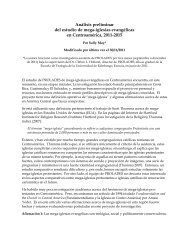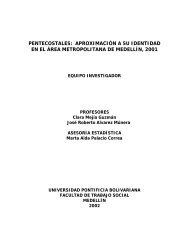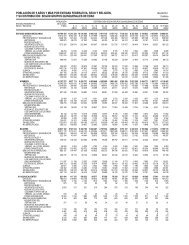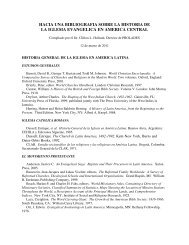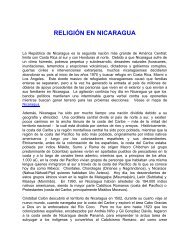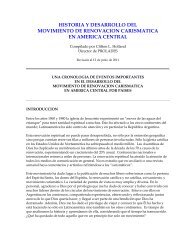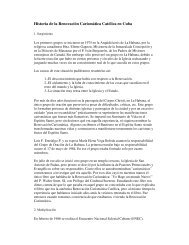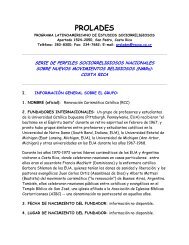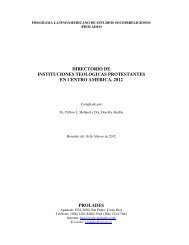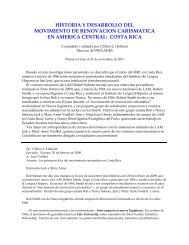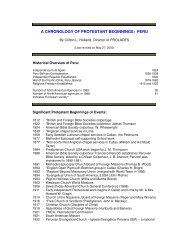belize, 1980 - Prolades.com
belize, 1980 - Prolades.com
belize, 1980 - Prolades.com
You also want an ePaper? Increase the reach of your titles
YUMPU automatically turns print PDFs into web optimized ePapers that Google loves.
to the 1950s, or have be<strong>com</strong>e associated with some of the newer denominations, such as<br />
Pentecostal groups. However, some elements of African Spirituality (such as magic, shamanism<br />
and sorcery—elements of Obeah and Voudun) are still practiced in secret, especially among the<br />
older generation. Also present among the Creoles are small, but socially significant, Black Muslim<br />
and Rastafarian <strong>com</strong>munities.<br />
3.2 MESTIZOS (33.4%, <strong>1980</strong> Census)<br />
The mixed Amerindian-Spanish population (called Ladinos in neighboring Guatemala)<br />
mainly lives in the northern lowlands and in the western regions of Belize, near the Mexican and<br />
Guatemalan borders. Although traditionally nominal Roman Catholics, growing numbers of<br />
Mestizos have responded to the message of the Gospel and be<strong>com</strong>e members of Protestant<br />
churches during the past two decades. The Nazarenes, Gospel Missionary Union, the Seventh-day<br />
Adventists and newer Pentecostal groups have grown considerably in the Orange Walk and Cayo<br />
Districts since the 1950s. However, the majority of the Spanish-speaking Mestizo population<br />
continues to practice a syncretistic "Cristo-paganism" with little understanding of Biblical Christianity.<br />
Between 1960 and <strong>1980</strong>, 10,679 Mexicans and Central Americans (mainly Guatemalans)<br />
immigrated to Belize.<br />
Since the taking of the <strong>1980</strong> Census, many refugees from El Salvador’s civil war have<br />
arrived in Belize, especially from the war-torn departments of Cabañas, Chalatenango, San Vicente,<br />
La Libertad and Morazán. Although some sources estimated that there may be as many as 15,000<br />
Salvadoran refugees in Belize, a recent study by USAID determined that only 1,585 Salvadorans are<br />
classified as “refugees” (as of mid-August 1983). Apparently, the flow of Salvadoran refugees into<br />
Belize has slowed or perhaps now stopped.<br />
3.3 AMERINDIANS (9.5%, <strong>1980</strong> Census – includes the Maya and Kekchí peoples)<br />
Most of the Amerindians in Belize are descendants of the ancient Mayan civilization, and are<br />
nominally Roman Catholic. In the south, Mopan Maya speakers migrate between the Petén<br />
Department of Guatemala and the Toledo District of Belize. The first large-scale immigration of the<br />
Mopan Maya occurred in 1886 to escape taxation and forced labor in Guatemala, which created<br />
new settlements in the Toledo District. Today, this ethnic group numbers about 5,500 in Belize, but<br />
the Mopan Maya evangelical <strong>com</strong>munity in Guatemala totals only about 120 people in three small<br />
churches. Both the Nazarenes and the Mennonites are known to have a few believers among the<br />
Mopan Maya in Belize, but the largest denomination among them is an independent Pentecostal<br />
group, known as the Kekchí and Mayan Churches of Belize. This denomination reported 15<br />
congregations and about 750 believers in the Toledo District in 1978; however, these statistics<br />
include both Kekchí and Mopan Maya believers. The New Testament has been translated into<br />
Mopan Maya by Wycliffe-SIL. Sixteen New Testament stories and several tracts also are available in<br />
Mopan Maya, in addition to a hymnal.<br />
The Kekchí (a non-Mayan group) live mainly north of Cobán in the Guatemalan Department<br />
of Alta Verapaz, but they are expanding into Izabal, Baja Verapaz and Petén Departments, and also<br />
into Belize. The first large immigration of the Kekchí occurred in the 1870s in order to escape<br />
enslavement by German coffee growers in Verapaz. More recently in Guatemala a Kekchí "people's<br />
movement" (mass conversions to Christianity) has occurred, where the evangelical population now<br />
numbers about 18,000 out of nearly 300,000 Kekchí. The size of the Kekchí population in Belize is<br />
given as 3,779 in the <strong>1980</strong> Census; their receptivity to the Gospel in Guatemala has apparently<br />
extended into Belize, where the Nazarenes also reported a people's movement among the Kekchí<br />
10



